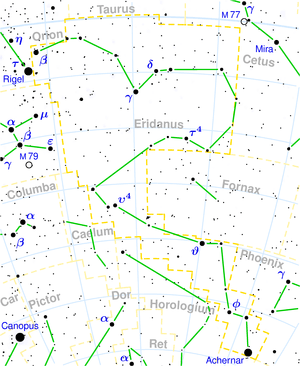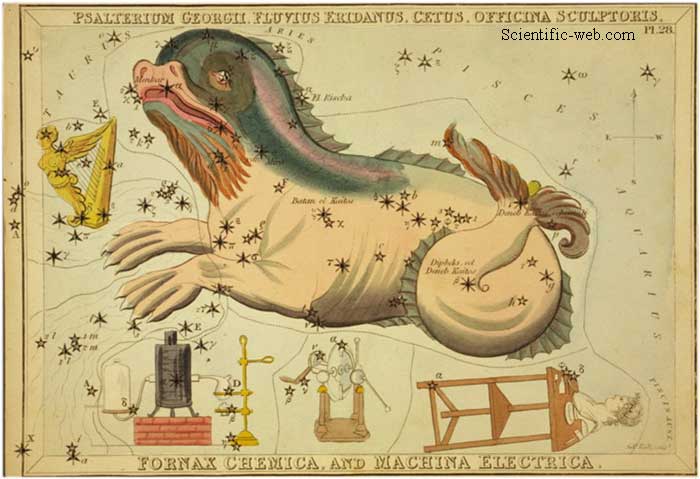- ^ NRAO: "Astronomers Find Enormous Hole in the Universe". NRAO website, retrieved 24 August 2007.
- ^ The void: Imprint of another universe?
- ^ Evidence for a parallel universe?
- ^ Great 'cosmic nothingness' found, BBC News.
|
|
Eridanus the ancient Greek name for the Po River (now in Italy), in the mythology associated with Phaëton) is the sixth largest of the 88 modern constellations. It was also one of Ptolemy's 48 constellations. Astronomical features in Eridanus Achernar At its southern end is the first magnitude star Achernar (α Eri). Achernar is a very peculiar star because it is one of the flattest stars known. Observations indicate that its radius is about 50% larger at the equator than at the poles. This distortion occurs because the star is spinning extremely rapidly. Epsilon Eridani Another well-known star in Eridanus is Epsilon Eridani, which has been popular in science fiction because it is relatively close and relatively sun-like. (See: Epsilon Eridani in fiction) It is now known to have at least one planet (see: extrasolar planet), which is thought to be a gas giant, like Jupiter. The Eridanus Supervoid The Eridanus Supervoid is the largest supervoid discovered to date (August 2007). At a diameter of about one billion light years it is much larger than any other known void (absence of galaxies) in the universe, and represents a challenge for current theories of the origins of the universe to explain. It was discovered by linking a 'cold spot' in the cosmic microwave background to an absence of radio galaxies in data of the US National Radio Astronomy Observatory's Very Large Array Sky Survey.[1] There are also suggestions that the void may due to Quantum entanglement between our universe and a Parallel universe.[2] [3] [4] See also: WMAP cold spot Mythology Eridanus is associated with two Greek myths, both likely to be derived from the shape of the constellation — that of a very twisty path. Eridanus was sometimes considered to be a river which flowed from the waters of Aquarius, and in such situations, Aquarius was considered to face Eridanus (requiring a change of angle, and this required the redesigning of how the stars of Aquarius connect, so that the water poured onto the same side as Eridanus). Eridanus was more usually connected to the myth of Phaëton, who took over the reins of Helios' (i.e. the Sun's) sky chariot, but didn't have the strength to control it, and so veered wildly in different directions. The result was that sometimes the chariot got too close to earth, creating desert and burning people's skin (a myth Greeks considered to explain the skin of the Ethiopians). Zeus intervened by striking Phaëton dead with a thunderbolt. The constellation was considered to be the path Phaëton drove along, according to the mythology. In later times, it was considered to be the river of the underworld that he fell into. Psalterium Georgii, Fluvius Eridanus, Cetus, Officina Sculptoris, Fornax Chemica, and Machina Electrica , (some older Constellations) Citations
References * Ian Ridpath and Wil Tirion (2007). Stars and Planets Guide * Star Names, Their Lore and Legend, Richard Hinckley Allen, New York, Dover, various dates Links
Retrieved from "http://en.wikipedia.org/"
|
|
||||||||||||||||||||||||||||||||||||||||||||||||||||


